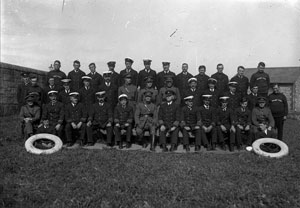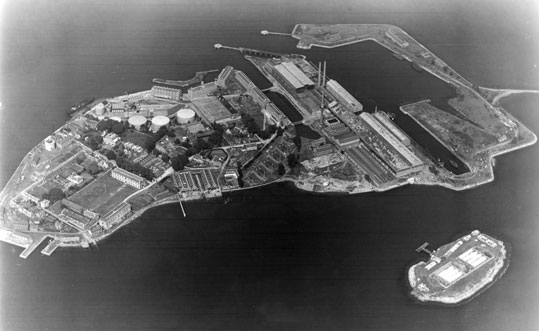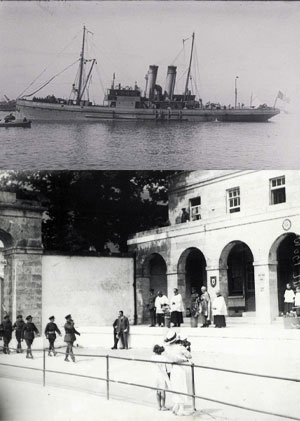THE TAKE-OVER OF THE NAVAL DOCKYARD AT HAULBOWLINE, 1923
Published in Features, Issue 1 (January/February 2023), Volume 31By Daire Brunicardi

Above: A group of the short-lived Coastal and Marine Service, 1923–4. Major-General Joe Vize, commanding officer, is in the centre of the front row.
The naval dockyard that the government of the Irish Free State took over in 1923 was an extensive site of docks, workshops, stores, accommodation, residences, oil storage and pumping systems, electricity generation, cranes, a railway all around the island and a large hospital. While it was a major facility and employer in Cork Harbour, in naval terms it was a small dockyard. With the Act of Union of 1801, local interests in the Cork area hoped to have Cork Harbour developed as a major naval dockyard port. Over the remainder of that century there were repeated representations to government on this topic. These succeeded only to the extent that Queenstown and Haulbowline were designated an ‘emergency’ or minor dockyard, and no ships were based there other than some small vessels for patrolling Irish coastal waters.
Cork Harbour and Queenstown did have one period of prominence. During the First World War, docks and shipyards at Passage West and Rushbrooke, but particularly Haulbowline dockyard, became fully active. Employment in the yard went up from a couple of hundred to over a thousand. With the end of the war, however, the Admiralty decided that it was surplus to peacetime requirements and set about shutting it down. This immediately caused protests and representations from local dignitaries and politicians, pleading for it to be kept open in some form.
PROVISIONAL GOVERNMENT TO MEET THE COSTS FROM APRIL 1922

Above: An aerial view of Haulbowline Island in 1940. There had been little change since 1923, except where Irish Steel Ltd occupies the location of the main dockyard workshops in the vicinity of the twin chimneys (Military Archives).
The War of Independence and the subsequent Anglo-Irish Treaty of 1921 changed the approach to and destiny of Haulbowline. The Provisional Government, in the form of Michael Collins, undertook to meet the costs of keeping the yard open, pending its hand-over as a going concern to the Irish Free State. There was considerable correspondence between the colonial secretary, Winston Churchill, the admiral at Queenstown and Michael Collins, including the following letter:
Baile Átha Cliath,
28 March 1922
Dear Mr Churchill,
I am in receipt of yours of the 20th Inst., and am glad to know that you have succeeded in prevailing on the cabinet to keep the dockyard open after 31 March. My colleagues have agreed with me that we should accept liability for sums advanced by your government for the maintenance of the yard after that date. We set up a committee of exports and businessmen to consider this matter, their report is now available, but owing to extreme pressure here, has not yet been considered. I trust it will be possible for the Admiralty to send a vessel for repair, as you suggest, at an early date, pending the practical application by us of the committee’s recommendations.
Yours faithfully,
(signed) Michael Collins
Most of the skilled workforce were offered pensions or re-employment in Devonport. Apprentices could also complete their ‘time’ there. In an ironic twist, a group of Irish apprentices who transferred to Devonport wrote to Michael Collins to ask him to press the British government to increase their allowances, quoting their credentials as IRA and Fianna Éireann activists!
The sum finally agreed in early 1923 was £60,000. The Admiralty had sought an additional £12,000 for the cost of maintaining the Royal Marine garrison on the island, but the Free State government demurred on the grounds that the Marines would be paid wherever they were stationed. Meanwhile, the Royal Navy was still in occupation on the island, with warships in the harbour. The extensive Admiralty and military property in the now-renamed Cove (Cóbh) had been handed over to the local IRA the previous year (1922) but had been destroyed when those (anti-Treaty) forces left at the start of the Civil War. The navy was involved in evacuating the numerous coastguard stations around the coast and gathering weapons, explosives and military stores for shipment to Britain. The daring and brilliantly executed raid in March 1922 on the British stores ship Upnor, and the taking of most of her cargo of weapons and other equipment, by the local IRA embarrassed both the Provisional Government and the British authorities.
HAND-OVER
Agreement was finally reached, and the yard was handed over on 31 March 1923 by Captain Aubrey Peebles RN to Sir Philip Hanson, chairman of the Irish Free State Local Government Board. At the same time, National Army troops under the command of a Commandant Love relieved the Royal Marine garrison on the island. Captain Lucas of the Royal Marines also handed over the launches, tugs and other plant. At 3pm the cruiser HMS Castor departed with the British garrison and other staff—and also, significantly, the last contingent of the RIC under Head Constable M’Gilligan. Two days later the Irish flag was formally hoisted at the signal station on the island in the presence of Mr M. Hennessy TD, Major-General Joe Vize, Senator Clayton Love, Captain Waters, Commandant Love, Captain O’Connell and Lieutenant Byrne. The Office of Public Works (OPW) took over responsibility for the dockyard. Included in its responsibility were the terms of the naval clauses of the Treaty, the maintenance of stores and stocks of fuel for naval use and the maintenance of two large mooring buoys for the Royal Navy ships that were to stay as a ‘presence’ in Irish waters.
COASTAL AND MARINE SERVICE
With the hand-over, the Coastal and Marine Service of the National Army arrived. This unit had been formed to provide a seagoing element, mainly to prevent arms-smuggling to the anti-Treaty forces, following the situation in which civilian ships had been chartered for the amphibious landings in the prosecution of the Civil War and subsequently for supplying the National Army and conveying prisoners from coastal towns to Dublin. The new service was a hastily formed unit employing mainly men from the mercantile marine. Its proponent and commanding officer was Major-General Joe Vize, who had drawn up extensive organisational details of ranks, bases, signalling procedures, uniforms and so on. These carefully avoided any ‘naval’ references so as not to infringe the terms of the Treaty, which forbade the Irish Free State to establish a navy. Initially four large seagoing motor launches were purchased from the UK and several small government vessels were taken over. In due course, twelve minesweeping trawlers were purchased in Britain, and several were put into immediate service patrolling the coasts and supporting National Army activities.
The arrival of the Coastal and Marine Service in Haulbowline did not go down well with the OPW. Naval stores were taken and buildings occupied without their permission. The biggest bone of contention was the use of the ocean rescue tug Dainty. This was a large seagoing vessel, armed with a twelve-pounder gun, which was part of the dockyard facilities. The Service took it over as their flagship, to the annoyance of the OPW, and an armed sentry had to be put on it when it was at Haulbowline to prevent OPW personnel from boarding and immobilising the engines.
The Coastal and Marine Service did not last long, however. The Department of Finance was horrified at the costs of vessel purchase and of bringing them up to operational standards. With the end of the Civil War the fleet was surplus to requirements. It was proposed that three of the twelve trawlers should be fitted as proper patrol vessels, and work was started on them in the dockyard. Shortly after that the government decided that the Service would be disbanded and all the vessels sold off. By 31 March 1924 the Service had ceased to exist.
DECLINE

Above: (Top)The armed ocean tug Dainty. Initially handed over to the Office of Public Works in 1923, its subsequent take-over by the Coastal and Marine Service caused a row. (Below) National Army troops march past the former RIC barracks at Haulbowline and salute the bishop of Cork in July 1923 (Military Archives).
The dockyard staggered on, getting minimal ship repair work. The workforce had been reduced to a handful. Attempts were made to find commercial buyers for the yard, but to no avail. Vital workshop equipment and craft were sold off piecemeal. For a while a ship-breaking firm leased the huge, magnificent graving dock. This led to a dispute when the dock was vacated, leaving it full of rubbish and scrap metal. Finally, in 1929 it was decided to shut the yard down completely. This involved an almost irreversible action. The pumps for emptying the basin and graving dock were below sea level, and there was continuous water leakage into the compartment, which had to be pumped out every two days. This required steam power. With the complete shut-down, the pump compartment was allowed to flood, thus destroying the pumps and rendering the graving dock unusable.
Another asset obtained in the hand-over was the hospital. This had been a major British naval hospital. It occupied one of the large storehouse buildings, a separate building for the officer wards and separate isolation wards for handling contagious diseases. Supporting facilities included a large laundry, a dispensary, staff residences, etc. This was taken over as the National Army military hospital for the South, pending the rebuilding of the hospital in the former Victoria Barracks in Cork, which was destroyed by departing anti-Treaty forces in 1922.
With the closing of the hospital there was no military presence on the island until the summer of 1940, when part of it was taken up as a depot for the newly formed Marine Service. The ships of the Royal Navy continued to come and go from the mooring buoys until 1938. They departed with the hand-over of the harbour defence forts and the buoys were removed. The basin was used to lay up shipping during the Great Depression, and some private enterprises, a small boatyard and a small oil refinery were established on the island.
In 1939 the larger part of the dockyard workshop complex was taken over by a State enterprise, Irish Steel Holdings Ltd, to recycle scrap metal and to provide much-needed employment in the area. It closed in 2001 and the site was cleared.
TODAY
Haulbowline is now the Irish Navy’s headquarters, base and dockyard. It continues a tradition of Cork Harbour as a naval station over the centuries. The hand-over in 1923 received little publicity, and its significance took decades to be appreciated in Ireland. Ireland is a maritime country. Its strategic position in the North Atlantic places it centrally in military and economic terms, often not appreciated in Ireland but recognised by other world powers. The Navy, based in Haulbowline, is key in this regard, as it is in the more appreciated areas of protecting the resources of the surrounding seas.
Daire Brunicardi is a retired Senior Lecturer in the National Maritime College of Ireland (NMCI), a constituent college of Munster Technological University (MTU).
Further reading
D. Brunicardi, Haulbowline, the naval station in Cork Harbour (Dublin, 2012).
T.McGinty, The Irish Navy: a story of courage and tenacity (Tralee, 1995).
P. Ó Confhaola, ‘The naval forces of the Irish State 1922–1977’ (unpublished Ph.D thesis, Maynooth University, 2009).
















